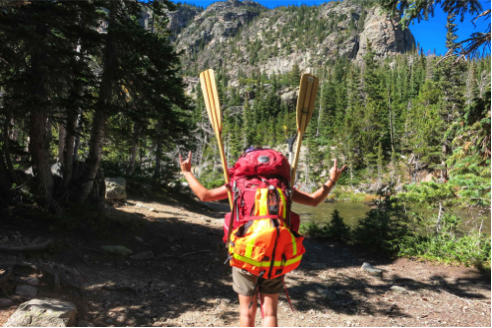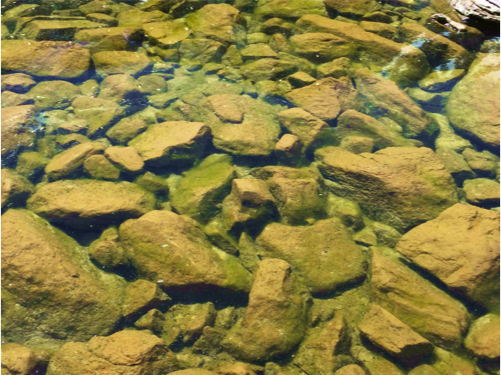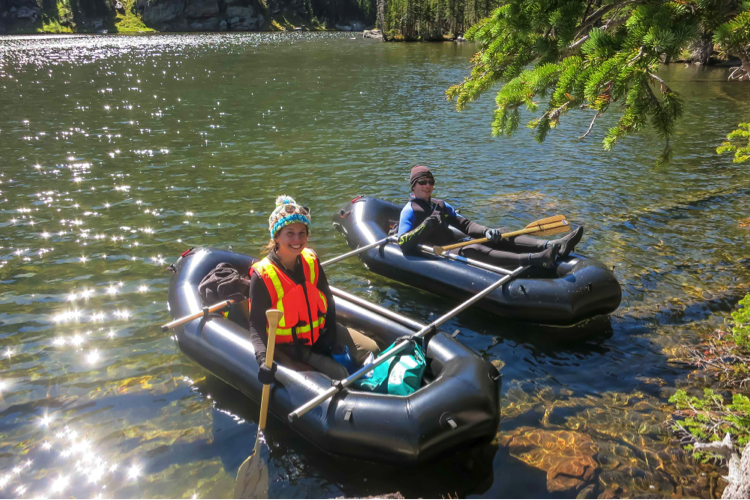
“Periphyton” or “Algae That Grows on Rocks”? Lessons Learned from Rocky Mountain National Park
| “Most of the fundamental ideas of science are essentially simple, and may, as a rule, be expressed in a language comprehensible to everyone.”
Albert Einstein |
An often-overlooked aspect of fieldwork in a romantic landscape like Rocky Mountain National Park (RMNP) is interaction with tourists and hikers who are curious about our work. Aside from filling water bottles for chemical analysis, sampling algae from rocks, and obtaining sediment cores, informing the public is another big part of our job.
Last summer my field crew and I sampled two alpine lakes in the Loch Vale watershed in RMNP at least twice a week. I study the coupled effects of chronic atmospheric nitrogen (N) deposition and climate change on alpine lakes. A few years ago, the Loch Vale research team noticed abundant algal growth along the shores and lake bottoms. Are the algae new? What environmental factors contribute to the growth of algae in such clean, clear waters? Are the algae responding to atmospheric N deposition, a warming climate, both, or neither? Our fieldwork involves boating around the lakes in the Loch Vale watershed on inflatable rafts to collect samples at pre-determined stations every week. We use a combination of conventional techniques and some new tools that allow us to estimate algal biomass in situ by quantifying chlorophyll-a fluorescence; this allows us to track changes through the growing season and look for patterns in response to temperature, light, and lake chemistry.

Based on my experiences, I offer advice to scientists who interact with curious bystanders. Here are my takeaways from a summer of fieldwork in Rocky Mountain National Park:
- Short but sweet. This isn’t always easy and definitely takes practice to refine. A two or three sentence summary is perfect. You should use common language and avoid terms that are specific to your field. For example, I would not tell a tourist that I am collecting periphyton, but rather “algae that grow on rocks.” Over the course of the field season I was able to develop a set of stock answers that allowed me to deliver my message efficiently. The key here is to summarize what you are doing eloquently and to give the listener a general understanding of the work you are doing and enough information to potentially pique their interest. From there, you can provide details, if they ask. Do they seem interested? Do they ask follow-up questions? I spoke with any number of different people—from a retired high school chemistry teacher to college students—who were all eager to learn, asked many questions, and even offered their own hypotheses. At this point, you can give more specifics and describe your research in more detail. Other times, your listener may say, “That’s great,” and move on.
- Tailor to your audience. Although I am basically studying how climate change affects alpine lakes, I try to avoid potentially inflammatory phrases like “global climate change.” Instead, I use more general and neutral statements such as, “over the course of our 35 years monitoring the biology, hydrology, and chemistry of this area, we have never seen this algae before. We are trying to understand why it is growing here now and what effects it may have on the environment.” If you don’t want to say climate change, you can emphasize that you are simply studying interactions between biology and abiotic factors such as temperature and nutrients. In this way, you can craft your message so that those that do not agree with you can at least hear what you have to say. This is important to remember if you work on or along private land—be sensitive to landowners who may not want you there or may be skeptical of your motives, even with a research permit.
- Analogies work in your favor. Don’t get bogged down in the details. Try to think of a simple analogy that explains a mechanism or concept in your study system. For example, the nitrogen cycle is complicated even for experts. Most people don’t understand what nitrogen deposition is or how it affects the national park. If you explain to someone that nitrogen is a component of air pollution and is transported in the atmosphere by local weather patterns, they can generally connect the dots as to how it gets to the park. If you use the analogy that nitrogen in rain is like fertilizer for an ecosystem, that further drives the message home. When describing less tangible aspects of your work, such as chemical transformations or components of food webs, put these interactions in a different context. For example, there is some evidence that filamentous green algae make a poor food source for consumers, so I sometimes compare a diverse suite of algae and bacteria to a colorful salad while comparing a dense mat of filamentous green algae dominated by a single species to a bowl full of kale stems. This helps illustrate the importance of diversity and nutrients in food webs with a simple analogy.
- Learn from your experience. This is subjective, but usually you can tell how effective your communication skills were after an exchange with someone. Does your explanation of your science stop a conversation dead in its tracks? Does your listener look away before you finish speaking? Reflect on your experiences and think about what you can do better. Don’t be afraid to experiment and try different approaches. If you have a long field season like me, you should have ample opportunities to do so. If you are with a field crew, brainstorm about how to convey your message more effectively. Don’t be afraid to ask for advice from your superiors. Few people are natural-born science communicators. It takes practice!
Communicating science in the field is something that most scientists, especially field ecologists, will encounter at some point in their careers. It is a valuable skill to have and undoubtedly translates into other realms of science communication. Don’t underestimate your ability to reach out to the public and educate, even if you only talk to one person at a time.

Isabella Oleksy is a Ph.D. student in the Graduate Degree Program in Ecology at Colorado State University as well as an NSF I-WATER fellow, working under the guidance of Dr. Jill Baron in the Natural Resource Ecology Laboratory.